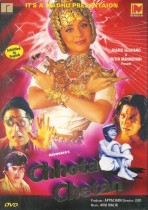'Is 3D going to be the future of Cinema?'

 The recent 3D buzz has got everybody asking, 'Is 3D going to be the future of Cinema?' India and China - home to two of the largest and still emerging box offices in the world will play a critical role in deciding the future of three-dimensional or 3D cinema. They are also home to two of the largest film industries in the world - Bollywood rolls out the maximum number of films per year and China produces only less than what Hollywood does. However when it comes to 3D, so far they haven’t shared Hollywood’s enthusiasm. Let’s take a look at how these industries are dealing with the new found interest in this century old technology.
The recent 3D buzz has got everybody asking, 'Is 3D going to be the future of Cinema?' India and China - home to two of the largest and still emerging box offices in the world will play a critical role in deciding the future of three-dimensional or 3D cinema. They are also home to two of the largest film industries in the world - Bollywood rolls out the maximum number of films per year and China produces only less than what Hollywood does. However when it comes to 3D, so far they haven’t shared Hollywood’s enthusiasm. Let’s take a look at how these industries are dealing with the new found interest in this century old technology.India
The 1984 Malyalam film - ‘My Dear Kuttichathan’ was India’s first experiment with 3D. It was so successful that 14 years later when it was dubbed in Hindi and released as ‘Chhota Chetan’ with additional sequences, it repeated its success story. Despite a few disjointed efforts e.g. Annai Bhoomi (1985), Aabra Ka Daabra (2004) etc. the Indian film industry never tried developing the infrastructure to take 3D to the next level but that was to change with the phenomenal success of ‘Avatar’ – the film that added a whole new dimension to Hollywood’s second innings with 3D and reminded the world about the exquisite nature of the medium.
Suddenly producers everywhere, including India, wanted a piece of the cake. This time industry picked up pace in building state-of-the-art technology and Bollywood was ready to present - ‘Haunted’ (2010) – the first major 3D production in two decades and despite the absence of popular names in the cast (which is very important in India where scripts are often written to favour and pamper the big stars) earned fairly well.
Riding the new 3D wave, it was Bollywood Badshah Shahrukh Khan’s turn to act and produce ‘Ra. One’ and ‘Don 2’. Although losing out to ‘Bodyguard’ (a 2D film) in the race to the biggest domestic hit of 2011, both the films went on to feature in the all-time top-grossing domestic films chart. However, their success had more to do with their star cast than the merits of 3D.
One obvious concern with popularity of 3D films in India is whether people are ready to pay for it. The increasing affordability of the growing middle classes in urban areas has been lucrative enough for the film industry to target them. This new breed of films has started picking up subjects and setups that are increasingly unfamiliar to the masses – mostly the rural and urban lower-income groups. This, to a certain extent, has led to a loss of Bollywood’s monopolist position in the market, triggering the monetary losses for the Mumbai-based (formerly Bombay) film industry in recent years. The continued popularity and box office supremacy of 2D over 3D may have just pushed the latter off Bollywood’s priorities.
Bollywood now faces a starker competition. One of the many reasons for its acceptance is that it has always been protective of the mass audience’s sentiment and audiences have paid back in abundance with their love and money. Now with Bollywood shifting its attention away from them, this portion of the audience have started turning to regional films that seem to have taken up the mantle of fighting the impossible war against the onslaught of an aggressive global homogeneity.
Although still the largest industry by far in India, Bollywood’s business has seen an overall drop against the Hollywood big-budgets and the regional superhits that have started to out-Bollywood Bollywood. The recent Bollywood releases for mass-audience pleasing such as ‘Rowdy Rathore’ and ‘Ek tha Tiger’, maybe an indication that B-town is eager to regain its lost glory. The apprehension whether 3D format will fit the Indian content and storyline, is also compelling Bollywood to take cautious steps.
With three new 3D films releasing later this year, it is clear that Bollywood will be monitoring the response of the audience, who seem to have accepted 3D as an outlandish experience restricted to fantasy genre. Their readiness to accept it as a part of their habitual diet is something that only time can tell. However, India’s neighbour has a different 3D narrative to tell.
China
 The country that made martial art films a genre in itself, is gearing up for revamped 3D editions of cool fist moves and jump kicks. With six thousand 3D screens being installed all over the country and as many as ten 3D television channels in the pipeline, China is the world’s largest 3D consumer market in making.
The country that made martial art films a genre in itself, is gearing up for revamped 3D editions of cool fist moves and jump kicks. With six thousand 3D screens being installed all over the country and as many as ten 3D television channels in the pipeline, China is the world’s largest 3D consumer market in making.China’s 3D tryst began with the 1962 production of ‘The Adventure of a Magician,’ but its attempt was short-lived as was the case in many other countries. Almost half a century later, China re-attempted to make a 3D film in the form of Happy Boys. This earned awful reviews. Misery continued when the box office performance of the 2010 3D film ‘True Legend’ failed to even match a third of its production costs. However, that didn’t dampen their spirits and the remake of ‘Dragon Gate Inn’ (1966) and ‘New Dragon Gate Inn’ (1992) - “Flying Swords of Dragon Gate” starring Jet lee earned the persistent 3D movement 100 million USD within the country alone.
Foreign 3D films have had a very successful outing in the Chinese market. Following Avatar’s trail, 2012 release of the 3D edition of the 1997 ‘Titanic’ did a massive business of more than 140 million USD – way more than the year’s biggest domestic hit ‘Painted Skin: The Resurrection’. Earlier this year, China opened itself to an additional 14 foreign films on top of the usual 20 films limit but these films will have to be in 3D or IMAX’s widescreen technology format. This, together with the steady growing Chinese urban market, means heyday for big budget 3D productions.
With the Chinese government emphasizing on the development of “Culture as a Business”, a lot of government endorsed as well as private commercial activities are taking place in the entertainment sector. China’s openness towards 3D has attracted many Hollywood studios in collaborative talks. The ‘Avatar’ director James Cameron is partnering with local companies to help Chinese filmmakers produce 3D films.
With Jackie Chan’s ‘Chinese Zodiac’ set to hit the screen in December, it will be interesting to observe how it fairs against its foreign counterparts.
Conclusion
It has always been easy for Hollywood to adapt to anything that is technologically challenging. After all Hollywood is known for its hi-tech visual effect blockbusters. In almost no time 3D has become a specialised medium for action packed sci-fi films and animations. Its popularity is such that Hollywood is now pushing its 3D limits to include films like ‘Step Up Revolution’ - a teenage dance flick. While domestic productions in India and China may not have stirred up a 3D revolution (yet), it’s apparent that they will continue experimenting with 3D to see the audience’s reaction to it and will not be lagging far behind. Yet to be fully accepted as a cinematic art form, 3D still has miles to go.
Mayur is an avid film enthusiast. A computer programmer by profession, he is based in Kolkata, India.
Similar content
By Kerrine Goh
19 Jan 2012
posted on
13 Aug 2010
By Kerrine Goh
22 Mar 2012
posted on
10 Sep 2011
posted on
13 Jun 2019






